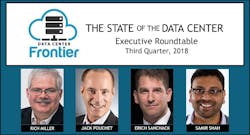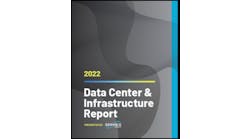Welcome to our 12th Data Center Executive Roundtable, a quarterly feature showcasing the insights of thought leaders on the state of the data center industry, and where it is headed. In our Third Quarter 2018 roundtable, we examine four topics: whether hyperscale has become its own segment of the wholesale market, what complex hybrid IT infrastructure means for DCIM software, the adoption of lithium-ion batteries in data center UPS systems, and whether underwater data centers are brilliant or crazy.
Here’s a look at our distinguished panel:
- Erich Sanchack, Executive Vice President of Operations at Digital Realty
- Jack Pouchet, Vice President of Market Development at Vertiv
- Samir Shah, Chief of Staff at BASELAYER
The conversation is moderated by Rich Miller, the founder and editor of Data Center Frontier. Each day this week we will present a Q&A with these executives on one of our key topics. We begin with a look at the hyperscale data center market.
Data Center Frontier: The largest hyperscale computing players are now seeking dozens of megawatts of power in wholesale data center deals. Is hyperscale now its own market segment, with different criteria and processes? Or can data center developers and the supply chain adapt to the full breadth of requirements in today’s market?
ERICH SANCHACK, Digital Realty
Erich Sanchack: Meeting Hyperscalers’ data center requirements is real estate, capital and resource-intensive, as they operate at much higher density and at much larger scale than general enterprises. The strength of your credit rating and balance sheet has to be able to support the necessary inventory and capacity, even as their needs continue to grow.
They are also looking for strong sustainability capabilities, with about half of our top 20 customers having 100 percent renewable goals and two-thirds of them having significant goals in that regard.
Digital Realty has been in this market for a long time, both prior to and boosted by our acquisition of Dupont Fabros last year. Just to give you an idea of the scope of our involvement, our top 10 cloud provider and top 10 content provider customers consume 518MW of power and occupy 6.76 million square feet of space in our data centers. Is it a stand-alone market? We certainly treat it as one.
JACK POUCHET, Vertiv
Jack Pouchet: There is the beginning of a bifurcation in the colocation marketspace at higher power levels, although the practice of a large, anchor tenant or single customer for the entire building has been common for many years. The change now is the scale of the power requirement for hyperscale clients often translates into a larger initial build and potentially a dedicated facility for a single client. The dedicated facility can not only meet the large power requirement but also the desire for segregated, secure, access-controlled facilities.
There still is plenty of room in the market for the more “traditional”’colocation facilities and we see plenty of new projects coming to market in the space. These facilities vary in size from a few megawatts upwards to 10 – 12MW with a campus environment to accommodate future growth. The vast majority of colocation clients do not buy space in 5 to 10MW blocks.
Samir Shah, VP of Product Management, BaseLayer
Samir Shah: Looking at how rapid and expansive the demand for data center capacity is, we clearly see “Hyperscale” as a category on its own. Hyperscale data centers are agile, flexible, scalable, and typically homogenous by nature and have different operational parameters as well as hardware and software requirements. Social media, e-commerce, IoT and cloud platforms are the driving forces behind hyperscale computing.
Data center developers, and the supply chain that supports hyperscale, are being counted on to supplement the capacity demand that Webscale brings. We’ve already seen vendors and manufacturers on both the IT and facilities infrastructure side put out specialized products and solutions for hyperscale. In the last couple of years there have been trade shows and conferences focused on Webscale. Having a separate and dedicated vertical focus on Hyperscale clients will allow industry players to better serve their customers and come up with innovative solutions for this target segment.
Hyperscale will trickle down enterprise level services, security and network to what was formerly the retail colocation customers. At the same time, due to the focus on large MW demand from hyperscale, capacity constraints may make “smaller” enterprise deals less appealing for colocation service providers.
This might create a boon for smaller regional players in the short term. Hyperscale will drive down margins and make cloud computing more affordable, pushing more non-Webscale clients to the Cloud. We also see a large opportunity for the proliferation of on-premise private cloud.
Keep pace with the fact-moving world of data centers and cloud computing by following us on Twitter and Facebook, connecting with me on LinkedIn, and signing up for our weekly newspaper using the form below:






